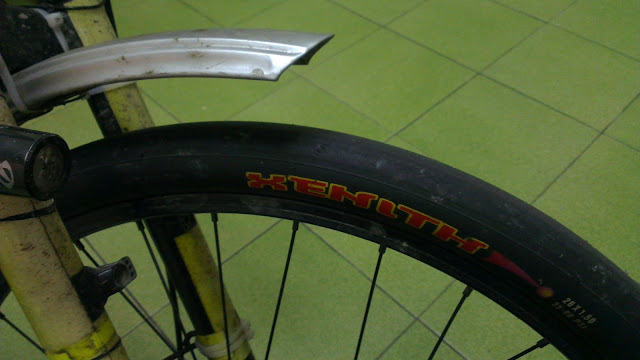When my old tires started showing signs of serious wear, it was time for a change. However, I learned a valuable lesson in going for the cheaper option.
I have a thing for Continental tires.
Back in my teens it was their MTB tires. The round profile was a nice break from the ultra-knobbly tires and made cornering on dirt a firm dirt a pleasure.
And when it was time to get on the road, Continental 26 inch slicks were where we all turned.

But times, they changed.
The bike shop that was closest to me in Taipei were unable to source Continental tires easily.
The owner recommended that I just get the Maxxis Xenith that they had in stock.
Very warily I took ownership of a set of tires from a manufacturer of tires I’d never used before.

The tires, they took a beating, have done over 10,000km to date and are still doing well for themselves after many hours on the road.
However, as time goes on, they are starting to show their age.
I was slightly concerned by the many little holes and nicks that had developed on the tires.

Although I tend to ride stuff until it breaks, my venturing into the world of long rides made me a little more conscious of my gear.
So I got a pair of Kenda Kwest from the local bike shop, because that is what they had, and the price was good.
The rubber is a good deal thicker and they are semi-slicks and looked okay. The price was also decent.
So I took the plunge.
And things were peachy… for a while… until.
BLOOOOOOOOOOP!
Bulging… huh?
One section of the rear tire just got huge and looked like it was going to burst. But didn’t burst. I actually rode it for a few more days and it remained the same size. It was like I was riding with a rock attached to my wheel… bump… bump… bump.
“Well, damn. Must have been something I rode over that caused this.”
So I let out all the air, removed the nasty tire and got to inspecting the situation.
Nothing.
Refitted tire with different tube. Who knows, maybe one of the sections of the tube with 5 patches was causing some funkiness. But alas, the same thing happened again.
So the old Maxxis (I never throw anything away) got a place on the rear wheel. No problems.
I continued happily riding for at least another thousand kilometers until one day…
BWOOOOOOP!
Another ballooning, this time in the front wheel.
So I made like Sherlock and went hunting for the source of this vexation.
And after some digging I found the culprit.

This was the enemy.
It was the tire itself that was to blame and all along I was trying in vane to defend it like a misbehaving family member. I honestly thought it was something to do with the tubes.
Evilness!
What prompted me to take a closer look at this part of the tire, and helped me actually come to the conclusion that this was the issue was a closer look at the outer casing from the outside.
Running my fingers around the whole tire pressing the outer layer, this section felt too soft and pliable.

Voila!
This soft section is what let this portion of the tire start ballooning.
Checking my other Kenda tire revealed the same issue.
I am now riding on my worn down Maxxis Xeniths again. And they are great.
I’ll wait until they are truly unusable this time.

Why does this all bother me so?
Because there is not much reason for a tire to be changed until it wears out. Yes, premature damage happens. But if you’re not doing stuff like this, then it shouldn’t.